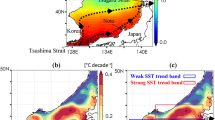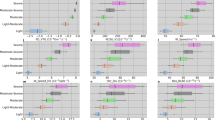Abstract
The Barents Sea is mostly ice-free during winter and therefore prone to severe weather associated with marine cold air outbreaks, such as polar lows. With the increasing marine activity in the region, it is important to study the climatology and variability of episodes with strong winds, as well as to understand their causes. Explosive marine cyclogenesis is usually caused by a combination of several mechanisms: upper-level forcing, stratospheric dry intrusions, latent heat release, surface energy fluxes, low-level baroclinicity. An additional factor that has been linked to extremely strong surface winds, is low static stability in the lower atmosphere, which allows for downward transfer of high-momentum air. Here the most extreme small-scale wind episodes in a high-resolution (5 km) 35-year hindcast were analyzed, and it was found that they were associated with unusually strong low-level baroclinicity and surface heat fluxes. And crucially, the 12 most severe episodes had stronger cold-air advection than 12 slightly less severe cases, suggesting that marine cold air outbreaks are the most important mechanism for extreme winds on small spatial scales over the Barents Sea. Because weather models are often unable to explicitly forecast small-scale developments in data-sparse regions such as the Barents Sea, these results can be used by forecasters as supplements to forecast model data.












Similar content being viewed by others
Notes
It is possible that this is due to WRF resolving smaller-scale features than ERA-Interim, but that is not investigated here.
It may seem strange that the overall ratio \(\widehat{\sigma }_{m}\) is higher than all the individual ones for the seasons, but this is due to differences in the annual cycles in WRF and the observations.
As mentioned earlier, the effects of latent heat release and differential diabatic heating are complicated to assess and will not be considered here.
Here, as in Bracegirdle and Gray (2008), the level at 700 hPa gave better results than the one at 500 hPa, probably because most of the systems are shallow.
References
Årthun M, Eldevik T, Smedsrud LH, Skagseth Ø, Ingvaldsen R (2012) Quantifying the influence of Atlantic heat on Barents sea ice variability and retreat. J Clim 25(13):4736–4743
Bader J, Mesquita MD, Hodges KI, Keenlyside N, Østerhus S, Miles M (2011) A review on Northern Hemisphere sea-ice, storminess and the North Atlantic Oscillation: observations and projected changes. Atmos Res 101(4):809–834
Baker LH, Gray SL, Clark PA (2014) Idealised simulations of sting-jet cyclones. Q J R Meteorol Soc 140(678):96–110. doi:10.1002/qj.2131
Bekryaev RV, Polyakov IV, Alexeev VA (2010) Role of polar amplification in long-term surface air temperature variations and modern Arctic warming. J Clim 23(14):3888–3906
Bracegirdle TJ, Gray SL (2008) An objective climatology of the dynamical forcing of polar lows in the Nordic Seas. Int J Climatol 28(14):1903–1919
Browning K (1997) The dry intrusion perspective of extra-tropical cyclone development. Meteorol Appl 4(04):317–324
Browning KA (2004) The sting at the end of the tail: damaging winds associated with extratropical cyclones. Q J R Meteorol Soc 130(597):375–399. doi:10.1256/qj.02.143
Chen F, Dudhia J (2001) Coupling an advanced land surface–hydrology model with the Penn State–NCAR MM5 modeling system. Part I: model implementation and sensitivity. Mon Weather Rev 129:569–585
Cleveland WS, Devlin SJ (1989) Locally weighted regression: an approach to regression analysis by local fitting. J Am Stat Assoc 83:596–610
Courant R, Friedrichs K, Lewy H (1928) Über die partiellen Differenzengleichungen der mathematischen Physik. Matematische Annalen 100:32–37
Dacre HF, Gray SL (2009) The spatial distribution and evolution characteristics of North Atlantic cyclones. Mon Weather Rev 137(1):99–115
Dee DP et al (2011) The ERA-Interim reanalysis: configuration and performance of the data assimilation system. Q J R Meteorol Soc 656:553–597
Duncan CN (1978) Baroclinic instability in a reversed shear flow. Meteorol Mag 107:17–23
Emanuel KA, Rotunno R (1989) Polar lows as arctic hurricanes. Tellus 41A(1):1–17
Føre I, Kristjánsson JE, Saetra Ø, Breivik Ø, Røsting B, Shapiro M (2011) The full life cycle of a polar low over the Norwegian Sea observed by three research aircraft flights. Q J R Meteorol Soc 137(660):1659–1673
Føre I, Kristjánsson JE, Kolstad EW, Bracegirdle TJ, Saetra Ø, Røsting B (2012) A hurricane-like polar low fuelled by sensible heat flux: high-resolution numerical simulations. Q J R Meteorol Soc 138(666):1308–1324. doi:10.1002/qj.1876
Gautier DL, Bird KJ, Charpentier RR, Grantz A, Houseknecht DW, Klett TR, Moore TE, Pitman JK, Schenk CJ, Schuenemeyer JH et al (2009) Assessment of undiscovered oil and gas in the Arctic. Science 324(5931):1175–1179
Grønås S (1995) The seclusion intensification of the new year’s day storm 1992. Tellus 47A(5):733–746. doi:10.1034/j.1600-0870.1995.00116.x
Grønås S, Kvamstø NG (1995) Numerical simulations of the synoptic conditions and development of Arctic outbreak polar lows. Tellus 47A(5):797–814. doi:10.1034/j.1600-0870.1995.00121.x
Gyakum JR, Danielson RE (2000) Analysis of meteorological precursors to ordinary and explosive cyclogenesis in the western North Pacific. Mon Weather Rev 128(3):851–863
Gyakum JR, Roebber PJ, Bullock TA (1992) The role of antecedent surface vorticity development as a conditioning process in explosive cyclone intensification. Mon Weather Rev 120(8):1465–1489
Hoffman RN, Leidner SM (2005) An introduction to the near-real-time QuikSCAT data. Weather Forecast 20(4):476–493
Holton JR (2004) An introduction to dynamic meteorology, 4th edn. Academic Press, Massachusetts
Hoskins BJ, Hodges KI (2002) New perspectives on the Northern Hemisphere winter storm tracks. J Atmos Sci 59(6):1041–1061
Hoskins BJ, Valdes PJ (1990) On the existence of storm-tracks. J Atmos Sci 47(15):1854–1864
Iacono MJ et al (2008) Radiative forcing by long-lived greenhouse gases: calculations with the AER radiative transfer models. J Geophys Res 113(D13):103. doi:10.1029/2008JD009944
Janjic ZI (1994) The step-mountain eta coordinate model: further developments of the convection, viscous sublayer and turbulence closure schemes. Mon Weather Rev 122:927–945
Kain JS (2004) The Kain–Fritsch convective parameterization: an update. J Appl Meteorol 43(1):170–181
Kolstad EW (2006) A new climatology of favourable conditions for reverse-shear polar lows. Tellus 58A:344–354
Kolstad EW (2008) A QuikSCAT climatology of ocean surface winds in the Nordic Seas: identification of features and comparison with the NCEP/NCAR reanalysis. J Geophys Res 113(D11):106
Kolstad EW, Bracegirdle TJ (2008) Marine cold-air outbreaks in the future: an assessment of IPCC AR4 model results for the Northern Hemisphere. Clim Dyn 30(7–8):871–885
Korablev A, Smirnov A, Baranova OK (2014) Climatological atlas of the Nordic Seas and northern North Atlantic. In: Seidov D, Parsons AR (eds) NOAA Atlas NESDIS 77
Lindzen R, Farrell B (1980) A simple approximate result for the maximum growth rate of baroclinic instabilities. J Atmos Sci 37(7):1648–1654
Liu AQ, Moore GWK, Tsuboki K, Renfrew IA (2004) A high-resolution simulation of convective roll clouds during a cold-air outbreak. Geophys Res Lett 31:L03101. doi:10.1029/2003GL018530
McInnes H, Kristiansen J, Kristjánsson JE, Schyberg H (2011) The role of horizontal resolution for polar low simulations. Q J R Meteorol Soc 137(660):1674–1687
Montgomery MT, Farrell BF (1992) Polar low dynamics. J Atmos Sci 49(24):2484–2505
Moore G (2013) The Novaya Zemlya bora and its impact on Barents Sea air–sea interaction. Geophys Res Lett 40(13):3462–3467
Moore GWK, Renfrew IA, Pickart RS (2012) Spatial distribution of air–sea heat fluxes over the sub-polar North Atlantic Ocean. Geophys Res Lett 39:L18806. doi:10.1029/2012GL053097
Noer G, Saetra Ø, Lien T, Gusdal Y (2011) A climatological study of polar lows in the Nordic Seas. Q J R Meteorol Soc 137(660):1762–1772
Nordeng TE, Rasmussen EA (1992) A most beautiful polar low: a case study of a polar low development in the Bear Island region. Tellus 44A(2):81–99
Petterssen S (1935) Contribution to the theory of frontogenesis. Geofys Publ XI(6):5–27
Rasmussen E (1985) A case study of a polar low development over the Barents Sea. Tellus 37A(5):407–418
Rasmussen EA, Turner J (eds) (2003) Polar lows. Cambridge University Press, Cambridge
Reeve MA, Kolstad EW (2011) The Spitsbergen south cape tip jet. Q J R Meteorol Soc 137(660):1739–1748
Renfrew IA, Moore G, Clerk AA (1997) Binary interactions between polar lows. Tellus 49A(5):577–594
Roebber PJ, Schumann MR (2011) Physical processes governing the rapid deepening tail of maritime cyclogenesis. Mon Weather Rev 139(9):2776–2789
Schultz DM, Sienkiewicz JM (2013) Using frontogenesis to identify sting jets in extratropical cyclones. Weather Forecast 28(3):603–613
Shapiro MA, Keyser DA (1990) Fronts, jet streams, and the tropopause. In: Newton CW, Holopainen EO (eds) Extratropical cyclones: the Erik Palmen memorial volume. American Meteorological Society, pp 167–191
Shapiro MA, Fedor LS, Hampel T (1987) Research aircraft measurements of a polar low over the Norwegian Sea. Tellus 39A(4):272–306. doi:10.1111/j.1600-0870.1987.tb00309.x
Skamarock WC et al (2008) A description of the advanced research WRF version 3. Technical Report. National Center for Atmospheric Research, Colorado
Stroeve JC et al (2012) Trends in Arctic sea ice extent from CMIP5, CMIP3 and observations. Geophys Res Lett 39(16)
Thompson G, Field PR, Rasmussen RM, Hall WD (2008) Explicit forecasts of winter precipitation using an improved bulk microphysics scheme. Part II: implementation of a new snow parameterization. Mon Weather Rev 136:5095–5115
Wang CC, Rogers JC (2001) A composite study of explosive cyclogenesis in different sectors of the North Atlantic. Part I: cyclone structure and evolution. Mon Weather Rev 129(6):1481–1499
Zahn M, von Storch H (2008) A long-term climatology of North Atlantic polar lows. Geophys Res Lett 35:L22702. doi:10.1029/2008GL035769
Zahn M, von Storch H (2010) Decreased frequency of North Atlantic polar lows associated with future climate warming. Nature 467(7313):309–312
Author information
Authors and Affiliations
Corresponding author
Rights and permissions
About this article
Cite this article
Kolstad, E.W. Extreme small-scale wind episodes over the Barents Sea: When, where and why?. Clim Dyn 45, 2137–2150 (2015). https://doi.org/10.1007/s00382-014-2462-4
Received:
Accepted:
Published:
Issue Date:
DOI: https://doi.org/10.1007/s00382-014-2462-4




